Animirani film prema stripovima ovakvih mamutskih razmjera (855 stranica) japanskog oca mange-za-odrasle (gekiga). A Drifting Life je autobiografski strip i neslužbena povijest mange.
Tatsumi: The Facsimile as Homage
by Ng Suat Tong
"Tatsumi (a cartoon adaptation of the manga of Yoshihiro Tatsumi) could be described as something of an anomaly — a project originating from Singapore which was made on the tiny island of Batam, Indonesia; a project no Japanese animation studio would have taken up if only because of its subject matter: slow, serious, immodest, and unsafe for children. The project’s unlikely instigator is one of Singapore’s most prominent directors, Eric Khoo, whose eighth feature this is.
Tatsumi represents Khoo’s first foray into animation. He dabbled in cartooning in his younger days, and those early works often reflect the urban angst and alienation found in many of his movies. As with Adrian Tomine (editor of the new Tatsumi translations published by Drawn & Quarterly), Khoo developed a passion for the gekiga of Tatsumi through the 1988 Catalan edition of Good-Bye and Other Stories. The motivation behind this project would appear to be simple. When asked about the impact of A Drifting Life (Tatsumi’s autobiographical manga) on him, Khoo had this to say:
“I could not stop thinking about it after reading it for three days and that’s when I decided I had to make a tribute film for Tatsumi.”At 98 minutes, this is a bare bones version of A Drifting Life, charting in short and somewhat cumbersomely narrated sections his beginnings as a young artist, his meeting with Osamu Tezuka, his family travails, and the birth of gekiga. The film is remarkably faithful to the source text with Tatsumi’s comics panels providing the key animation frames and serving as a near rigid storyboard. Interspersed with the snippets of autobiography are adaptations of at least five works from the author’s 70s oeuvre, namely “Hell”, “Just a Man”, “Occupied”, “Beloved Monkey”, and “Good-bye”. These stories can be found in the collections Abandon the Old in Tokyo and Goody-bye, and are derived from the best period of Tatsumi’s work. There are also short sequences from Tatsumi’s pulp comic, Black Blizzard, highlighting and fetishizng its trashy roots by means of a faux four color process not dissimilar to the effect found on the cover of the Drawn & Quarterly edition of the same manga.
Despite Khoo’s personal affection for A Drifting Life, the fragments in the film derived from that novel are undoubtedly the weakest sections, serving largely as somewhat forgettable links to the five main manga adaptations found therein. Even cut down to its basics these segments will try the patience of viewers with any familiarity with the source material. The segment on Tatsumi’s meeting with Tezuka are the most coherent, the rest is inconsequential filler with little emotional drive. Worst of all is the clumsy and melodramatic episode depicting the destruction of the young Tatsumi’s art by his ailing brother.
The real aesthetic failure of Khoo’s film occurs in the differentiation between the autobiographical scenes and the fictional story elements. This blurring of lines may in fact be intentional — a reflection of the largely unvarying style Tatsumi uses for all his projects and also a subtle suggestion that Tatsumi’s violent themes emerged from his own torn psyche. The autobiographical sections are done in a kind of animation short hand (undoubtedly the product both of intention as well as budgetary constraints) and are shown in color for the most part. The fiction adaptations are done in raw black and white, and are more purposefully two dimensional to indicate the source material. Blurred elements intrude into the frame to mimic a camera lens’ shallow depth of field, and the figures are designed and drawn in a vigorous scrawl typical of Tatsumi’s pre-70s comics. They have none of the refinement of Tatsumi’s ink work found in stories such as “Sky Burial” and “Abandon the Old in Tokyo”. The light and breezy tone of A Drifting Life barely registers, and the segments covering it remain resolutely stiff and leaden, no different from the pre-70s strips they unwittingly mimic. The overall effect is not unlike a slightly evolved motion comic. The lack of aesthetic separation between the two narrative strands leads to a certain monotony; life and art inseparable yet flat in affect.
Sound is the one enhancing element in Khoo’s film. While the dubbing of the American soldier in “Good-bye” is calamitous (imagine John Wayne in a sex scene), the panting and gasping of coitus is wisely heightened to a pornographic hyper-reality which is totally in keeping with Tatsumi’s narrative ethos. Where Tatsumi shows us no more than one page of incestuous licentiousness, Khoo’s version is a loud, drawn out fucking.
It surpasses its source material because of its perverse animalism and utter lack of subtlety. The central hook of incest in “Good-bye” might have been sufficient in Tatsumi’s era but no longer. Producing an adaptation some 40 years later, Khoo periodic attempts to intensify the audience’s disgust and revulsion is largely a successful one.
This isn’t the only time that the film adaptation highlights minor weaknesses in the original. The words streaming across the panels in an apartment scene in “Beloved Monkey” (see below) fall short of the more effective and annoying repetition of a stuck record player in Khoo’s movie.
Similarly, the crowd in the final moments of the same story is considerably more threatening — closer, less accommodating, and more menacing — in the film version .
This may be a case of creative licence. The placidity of Tatsumi’s pedestrians suggest an over-reaction on the protagonist’s part, a festering agoraphobia. Khoo’s adaptation assures us of the validity of this fear. Whether these divergences simply reflect the relative strength and weaknesses of the respective mediums is a subject for another day.
The decision to animate the pornographic graffiti in ”Occupied” also yields good results; coarsening the almost asexual nature of Tatsumi’s depictions of female nuditity.
Yet Khoo oversteps the material near the end of his adaptation, introducing a cacophony of siren sounds where none exist in the manga; dampening the faint ambiguity of the manga’s conclusion. It is never clear from the manga whether the protagonist of “Occupied” is apprehended by the police. The film makes certain of this by adding the sound of handcuffs.
The subjective lengthening of the material which works so effectively for the scenes of lasciviousness has its occasional drawbacks. For instance, the opening scenes of a bombed out Hiroshima in “Hell” which are tediously drawn out and which quickly outstay their welcome. Every scene Khoo includes in his adaptation may be found in the original comic, and those 3 pages of ineffectual drawing are faithfully refashioned into a ham-fisted opening sequence only likely to impress the naive and uninitiated.
One might say that the weaknesses in Tatsumi’s stories are brought to vivid life in Khoo’s animation. The manner in which the secretary (Okawa) propositions her elderly boss towards the close of “Just A Man” drew giggles of disbelief from the audience on the night of my screening. In contrast, the panel work in Tatsumi’s manga simply slips past the reader in a matter of seconds causing little if any consternation.
More damaging than all of this is the frigid depiction of creativity; devoid of any sense of the artist’s passion except through the histrionics of the young Tatsumi (in the animation) and the personal claims of the narrator. The final act — that final moment of artistic revelation — where Tatsumi creates a drawing of his old neighborhood falls flat on its face due to the sheer mediocrity of the final product.
Still, the sheer faithfulness of Khoo’s adaptation makes it a perfect tool for publicity, particularly in reference to those who still see comics and animation as the province of children. As Khoo suggests in his interview at Indie Movies Online:
“Because I’m such a fanboy, I hope that people will see Tatsumi and realise “Hey, there’s something to these stories,” and maybe go and buy A Drifting Life, and read 800 pages-worth of his life.”This is a perfect encapsulation of the film’s worth — a paean to a cartooning deity, a devoted act of promotion, and middling entertainment for the most discerning.
_______________________________________
Related MaterialA substantive interview with Eric Khoo at Indie Movies Online
EK: What I told everyone is that, “We will use all his panels as the storyboard of the film.” We do not create any additional shots. Everything must be from the source. And what that meant was that some of the stories I had to edit. The hardest was his life. 800 pages! I had to condense it down to 35 minutes!"
Products by Yoshihiro Tatsumi
|
 |
||||
 Preview (PDF) |
|
||||
|
 Preview (PDF) |
||||
 Preview (PDF) |
| ||||
|
 Preview (PDF) |
||||
 Preview (PDF) |
|
||||
|
 Preview (PDF) |
||||
 Preview (PDF) |
|
||||
|
 | ||||
Manifesto of a Comic-Book Rebel
By DWIGHT GARNER

Yoshihiro Tatsumi/Courtesy of Drawn & Quarterly
A memoir looks back at the roots of gekiga, Japanese comic book art’s dark side.

Asakawa Mitsuhiro
Yoshihiro Tatsumi in 2005.
Mr. Tatsumi began drawing manga as a child, but he quickly rebelled against the form’s aesthetic limitations. Manga was aimed largely at children, and its emotional and intellectual palette was circumscribed. Along with a cohort of young writers and illustrators, Mr. Tatsumi introduced in the late 1950s a bolder form of manga he called “gekiga” — darker, more realistic, often violent. The name stuck. And he became one of Japan’s most important visual artists.
Mr. Tatsumi’s work, long unavailable in English, has begun to be translated and issued by the Canadian publishing house Drawn & Quarterly in an annual series of books edited by the cartoonist Adrian Tomine. Now comes the big kahuna: Mr. Tatsumi’s outsize autobiography, “A Drifting Life.”
It’s a book that manages to be, all at once, an insider’s history of manga, a mordant cultural tour of post-Hiroshima Japan and a scrappy portrait of a struggling artist. It’s a big, fat, greasy tub of salty popcorn for anyone interested (as Americans increasingly are) in the theory and practice of Japanese comics. It’s among this genre’s signal achievements.
Manga, like rock ’n’ roll, is fundamentally a young person’s game. Mr. Tatsumi, 73, was born the same year as Jerry Lee Lewis; “A Drifting Life” was 10 long years in the drafting. But no strain of composition shows in this book’s marathon 855 pages, which chronicle his career from 1945 to 1960, the period of its greatest ferment.
Mr. Tatsumi was, he explains here, a geeky comics genius from the time he was in short pants. He began to draw manga in seventh grade in Osaka. Soon published widely, he formed a groundbreaking group, the Children’s Manga Association. The form’s masters were like gods to him. “Stories that capture the minds of children all over Japan,” his character says to himself. “How amazing it must be to be the person creating them.”
If success came quickly, confidence did not. Mr. Tatsumi’s family was poor. His father, a philanderer, was barely and sometimes shadily employed. Mr. Tatsumi’s mother and his three siblings made do as well as they could. Drawing manga was the author’s ticket to ride.
Once he was finished with school, Mr. Tatsumi began toiling in the cheesy, exploitative and highly competitive field of “rental manga.” These books were grab-bag collections that printed the work of several artists; readers borrowed them from stores and then returned them like video rentals.
Publishing houses cranked out rental manga like so much spicy sausage. To get the work done, publishers sometimes crammed their writers and illustrators into communal apartments for days or weeks at a time. In one scene in “A Drifting Life,” a publisher delivered a watermelon to one such apartment to “keep up your morale.”
Mr. Tatsumi does not deny the pleasures of this kind of quick-and-dirty work. His comics were being devoured by a wide and eager audience, and he was honing his craft. “For this 19-year-old boy with no guarantees for his future,” he writes, “the only place where he felt alive was in the realm of imagination.” There was “no freedom in reality,” he continues, but “any kind of transformation was possible in the imaginary world.”
All along, however, Mr. Tatsumi was also dreaming of something better: experimental work, “manga that isn’t manga.” He became obsessed with movies, both American and Japanese, and took note of their stylized visuals and their cool realism. He wanted to produce narrative comics instead of “manga with wild characters jumping about” or “manga that concerns itself with ‘humor’ and ‘punch lines.’ ”
After watching “Shane,” he was taken with the vividness of Jack Palance’s cruelty. And he fell hard for Mickey Spillane’s hard-boiled phrasings. Mr. Tatsumi drafted a “Gekiga Manifesto” and, along with a group of like-minded artists, started a movement that ultimately changed the face of manga.
As “A Drifting Life” progresses, it becomes clear that Mr. Tatsumi is not content merely to tell his own story — or just the story of gekiga. He charts Japan’s small cultural milestones in the wake of the war. This book begins with a panel depicting Emperor Hirohito’s surrender but soon moves on to topics like Japan’s first domestically manufactured washing machine, its Miss Universe contestants, maritime disasters and taste for Coca-Cola. It’s ground-level pop history.
The rap against graphic novels or memoirs is that they’re a bastard form that guarantees that both the art and the writing will be second-rate. There’s a speck of truth there, to the extent that the relationship between illustration and prose, in long-form comics, is symbiotic: you wouldn’t necessarily want to pry one from the other.
Mr. Tatsumi’s prose has been translated from the Japanese, fluidly, by Taro Nettleton. The occasional banalities of the language are, you suspect, not the translator’s fault. But I wish Mr. Nettleton hadn’t continually saddled Mr. Tatsumi with long-winded verbs like “utilized” instead of simple ones like “used.”
Mr. Tatsumi’s art is more sophisticated, retaining the form’s strange sparkle even at gloomy moments; he definitely does write manga that isn’t quite manga. The genre can be a difficult one in which to portray aging. Mr. Tatsumi looks just about the same here at ages 10 and 25.
A book like “A Drifting Life” is fairly easy to pick apart on a drawing-by-drawing or line-by-line basis. Don’t make that mistake. Its pleasures are cumulative; the book has a rolling, rumbling grandeur. It’s as if someone had taken a Haruki Murakami novel and drawn, beautifully and comprehensively, in its margins."
"Born in 1935 and a published mangaka before he was out of high school, Yoshihiro Tatsumi has enjoyed a long and prolific career, albeit one unfamiliar to English-speaking readers prior to Canadian publisher Drawn & Quarterly’s recent efforts to translate his body of short works. Three collections have been produced under the editorship of cartoonist Adrian Tomine: The Push Man and Other Stories (2005), Abandon the Old in Tokyo (2006), and Good-Bye (2008). In each volume, Tatsumi delivers curt, sharp slaps of city angst as his near-identical characters wander hazily through doomed, damned times—usually the ’60s and ’70s (when the works were originally published), but sometimes stretch-ing back to the hell of postwar occupation or becoming unmoored in a nightmare of timeless desire.
This is the stuff of Tatsumi’s gekiga, the term he coined in the mid-’50s to differentiate his “dramatic pictures” from the “whimsical” ones of manga. You don’t hear a lot about gekiga today, and certainly Tatsumi’s strange, disquieting stories don’t fit North Americans’ typical conception of Japanese comics. But while the sho-nen (boy) and sho-jo (girl) series common in American bookstores extend into an intimidating number of volumes, their content is often schematic, so thoroughly vetted for their youth audience that many seem adopted from some hornbook. Much manga targeted at older audiences is published in Japan, but the few such books brought to North America are often subsumed under the general category of youth comics. In that sense, it’s helpful to see manga in the United States today as being akin to the form in ’50s Japan: growing in popularity but firmly a youthful presence, its potential understandable, if only to the devout.
And so, again, comes Tatsumi. A Drifting Life is different from his other Drawn & Quarterly books. It’s a new work, for instance—made over an eleven-year period—and a single, extended narrative, more than eight hundred pages long. It’s also patently autobiographical, despite the artist’s use of the invented name Hiroshi Katsumi for his narrative stand-in. Yet the most obvious departure from those prior books is the tone. Anyone expecting page after page of relentlessly bleak atmosphere and manic despair will be disarmed by the calm, anecdotal means by which the artist relates fifteen years of his life, from August 1945 to June 1960. The narrative is most comparable to stories by the American comics writer Harvey Pekar, who is always front and center in his work, relating events straight from his life (or someone else’s) with little fuss.
Although much longer than the average Pekar comic, A Drifting Life nevertheless feels similar. Reading it is not unlike sitting down with Tatsumi himself and listening to his tale over several hours, savoring aptly placed digressions into popular culture and social landmarks—the start of television broadcasting, the first importation of Coca-Cola—that keep the time line pulsing. His art hasn’t changed much since the short stories of three decades ago, although there’s some stiffness now to his figures, particularly his pretty girls, and the historical nature of the narrative has prompted him to include what appear to be drawn versions of photographs depicting important events and characteristic settings of the time, along with many samples of pertinent period manga he’s redrawn.
But Tatsumi’s style remains a product of the manga scene of midcentury Japan. Even in the darkest stories, the artist’s simplified cartoon characters remind the reader of Tatsumi’s proximity to the reinvention of the art form, a generation before, by Osamu Tezuka, a devotee of Disney and a fan of cinematic framing techniques. Indeed, Tatsumi’s gekiga shorts have always carried both an anxiety of influence and the charge of a response, an eagerness to bite back at the manga that didn’t grow up after the war alongside its fanatic boy readership. In A Drifting Life, the same conflicted attitude is appropriate as an expression of the times depicted and as a way of foreshadowing the mature content Tatsumi would engender. The dreamy progression of images found in those gekiga stories is absent here. After all, this is reality, and Tatsumi is older. And gekiga, no doubt, is not what it used to be.
Chapter by chapter, the story burbles by. This measured flow sometimes produces a dispassionate narrative: A scene in which young Katsumi happens on his father lying beaten in the road has roughly the same space and dramatic impact as when he creates a new comic to submit for prize money. Tellingly, the most suspense in the book’s early chapters comes from a visit to the great Tezuka, first imagined as a looming shadow watching our manga-crazy boy. The impact Tezuka had on Japanese comics was profound, and Tatsumi allows a sequence of his hero sketching to span a lavish page and a half, in which intense close-ups of a blank page become filled with life as Tatsumi’s panels dart to Katsumi’s face, then closer to the page, then his eyes, then the page, until the “magical” experience—as Katsusmi characterizes it—is completed.
Little else receives such intensive treatment, including Katsumi’s close relationship with his ailing brother, Okimasa, also a prospective manga artist and often intensely jealous of Katsumi’s quick success. Their arguments are conveyed with gnashings of teeth and fat dollops of tears, but these are employed only as basic signifiers of feelings and do not provide an affecting sense of emotional sincerity. After a few panels, it’s right on to the next anecdote, emotions cooling as life marches forward.
Yet as dry and disaffected as Tatsumi’s approach can be, the book still fascinates. It is by far the most detailed first-person account of the early days of postwar manga available in English (let alone in manga form), and its purposeful stride through the years makes for brisk reading. Narrative color arrives as Katsumi falls into the business of creating manga aimed at the kashibonya, or book-rental market. (Publishers in the Osaka of Katsumi’s time are practically run out of back rooms.) Soon the artist is making friends with like-minded peers, none of whom will be familiar to most English-language readers—save maybe for Takao Saito, creator of the popular assassin series Golgo 13, first published in 1969— and none of whom possess much individuality in Tatsumi’s narrative, although their presence allows for the reproduction of old-time manga pages, which take up an increasing amount of space in Tatsumi’s own pages.
Naturally, the thrill of the new can’t last forever. Almost as soon as Katsumi and his brother invent gekiga, the former is editing influential anthologies, getting caught up in the machinations between publishers, and acting as point man and treasurer for a group of united artists called Gekiga Workshop, a demanding position that saps his enthusiasm for his own work. Through the din of these events, a grander theme sounds—postwar Japan’s desire for full autonomy, which crests in June 1960 with protests against the American presence in the country. After the close of Katsumi’s story here, Tatsumi would go on to create the short works he’s best known for, and the epic concludes with a sharp hint of what’s to come: Katsumi stuck in a street demonstration against a security treaty with America, eventually shouting along, tears streaming down his face. “Japan, too, is adrift!” he realizes. “That’s the element that gekiga has forgotten . . . anger!” Katsumi is excited and moved yet consumed with a deep loneliness. “No! I’ll never be done with gekiga!”
Yet even that passion cannot persist, as such a methodically drifting book bears out. An epilogue takes us to a 1995 memorial service for Tezuka attended by Katsumi. The postwar dream, embodied in comics by Tezuka, has died. Katsumi slips out early, only to receive a souvenir bag. Among the contents: official “Jungle Emperor Leo” whiskey, melding adult inebriation with Tezuka’s beloved children’s character (known in America as Kimba the White Lion). It’s a telling symbol of how the art form has evolved in Tatsumi’s lifetime—sweet idealism turned to commercial consumption. This book may not draw attention away from other Japanese comics on the shelves, manga or gekiga, but its presence feels curiously necessary." - Joe McCulloch

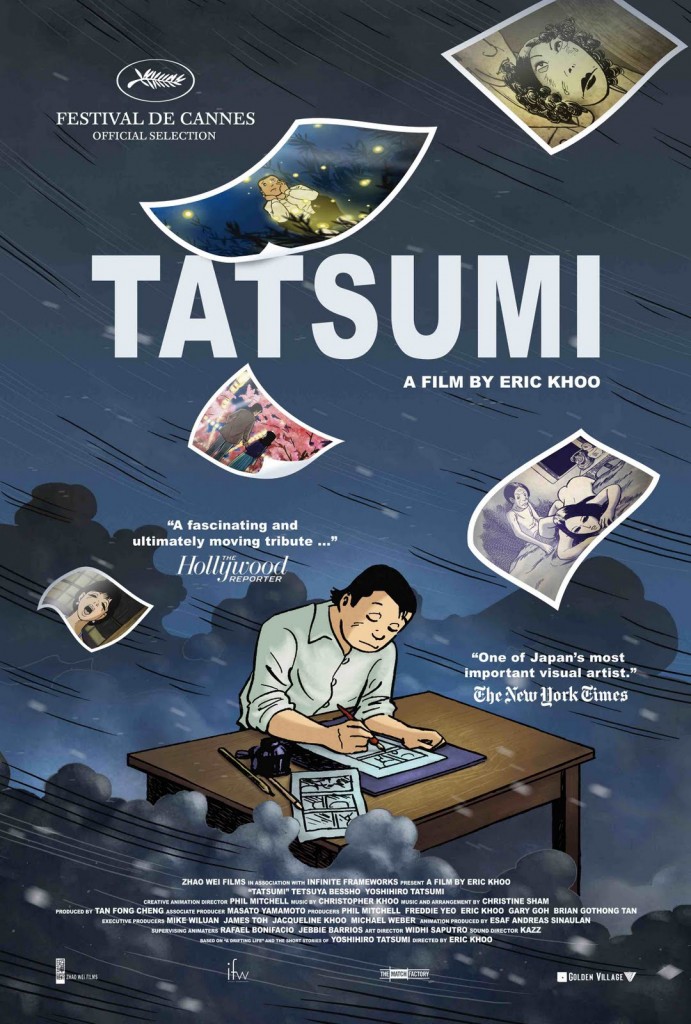
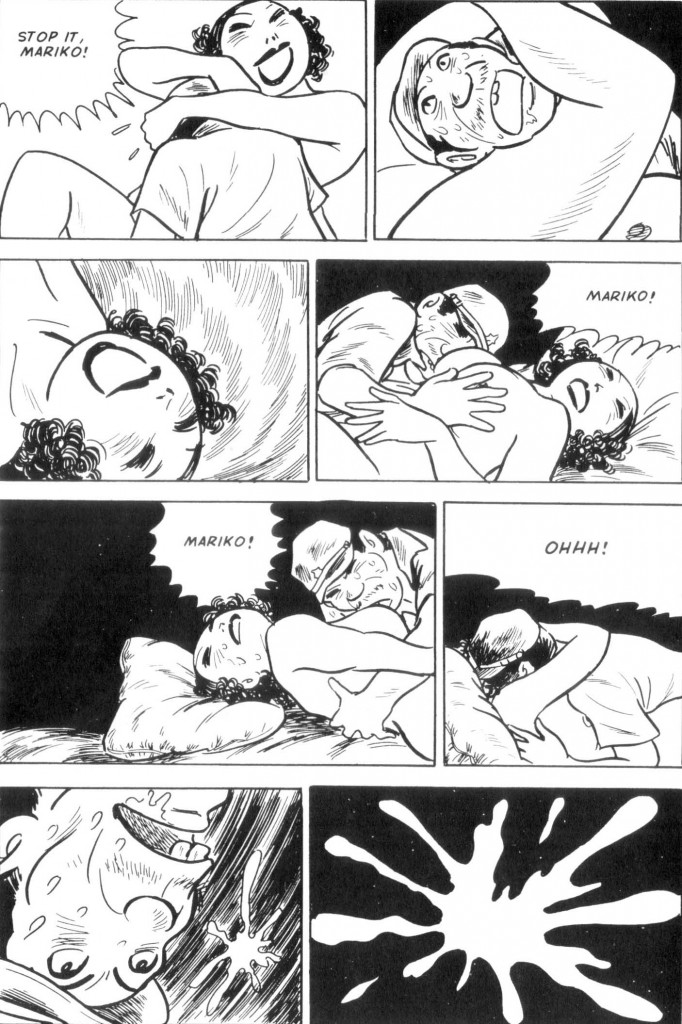
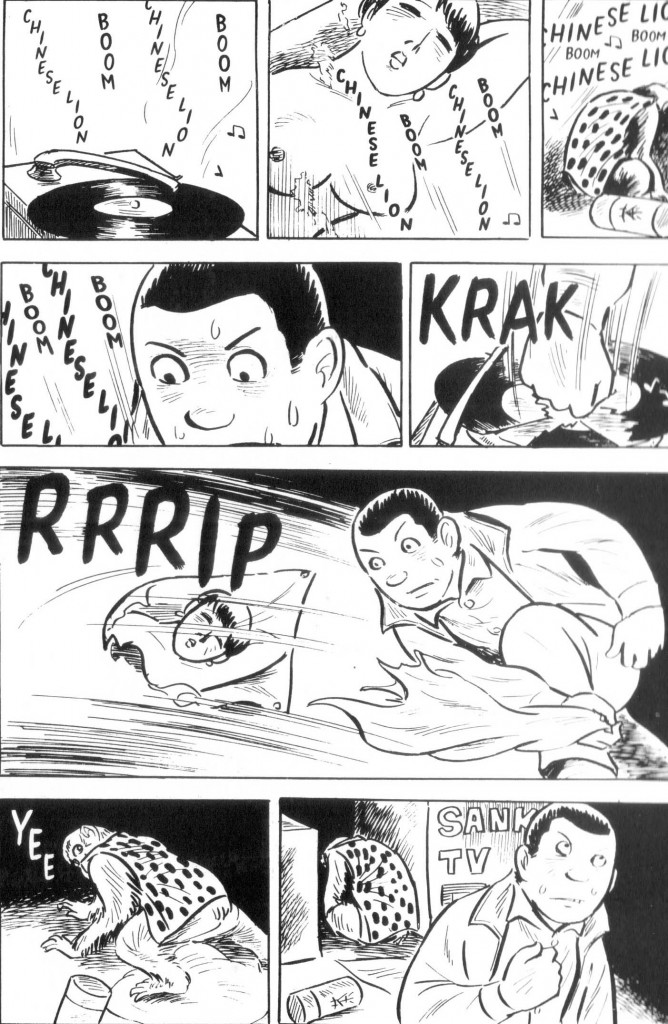
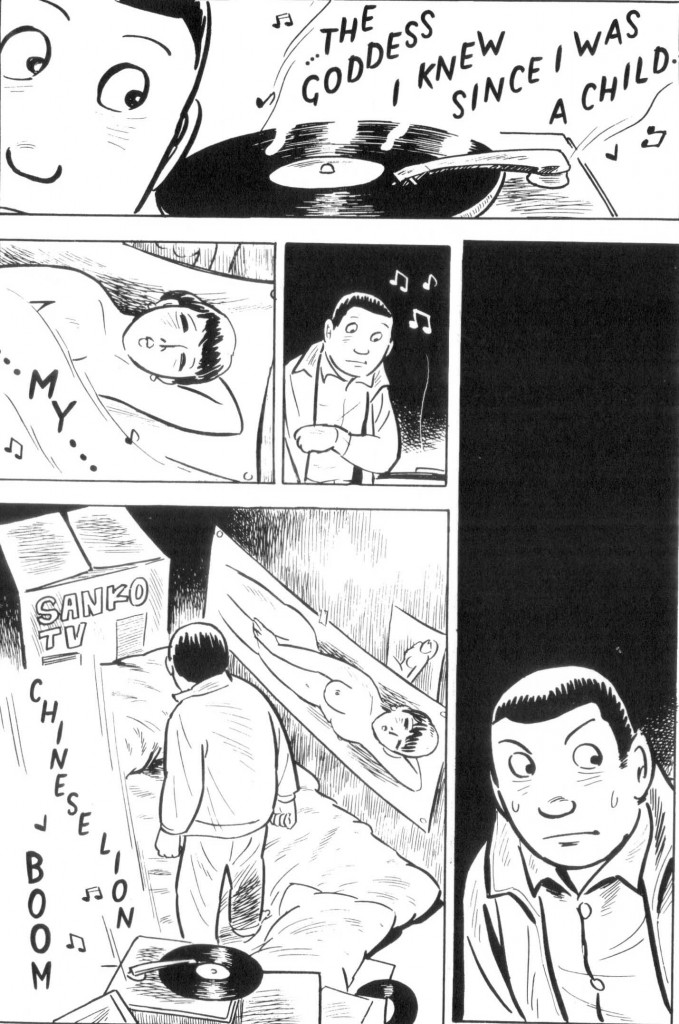
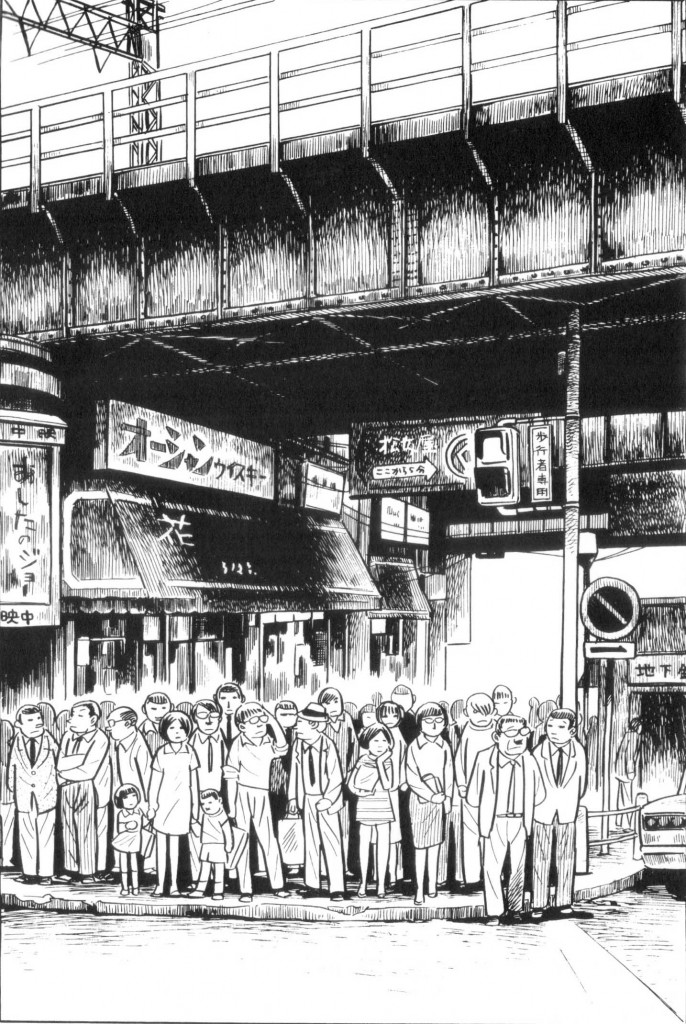
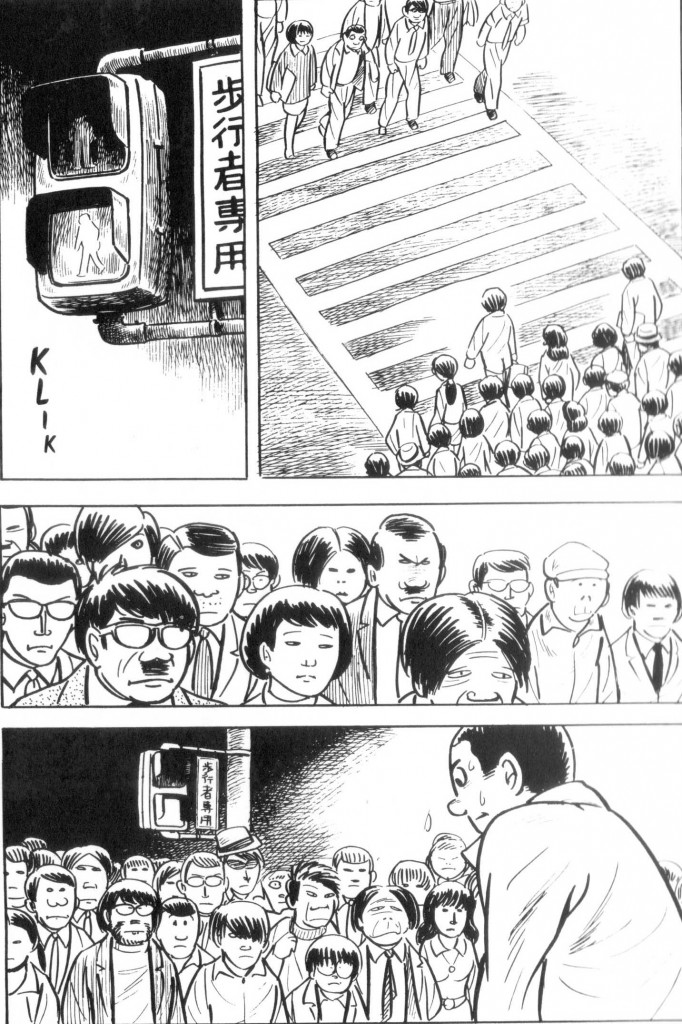
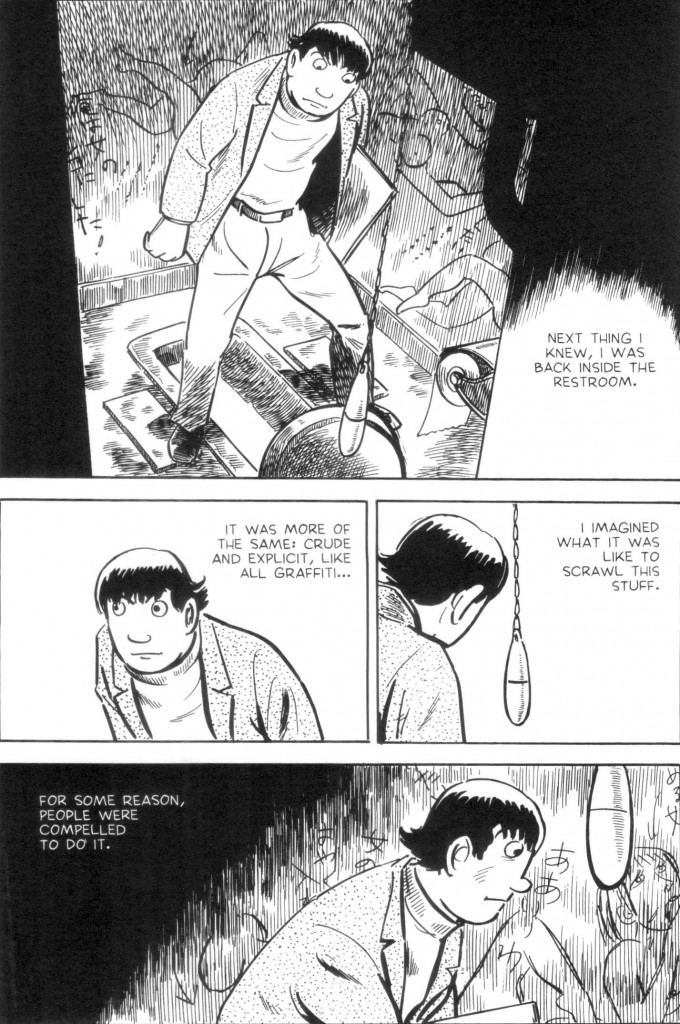
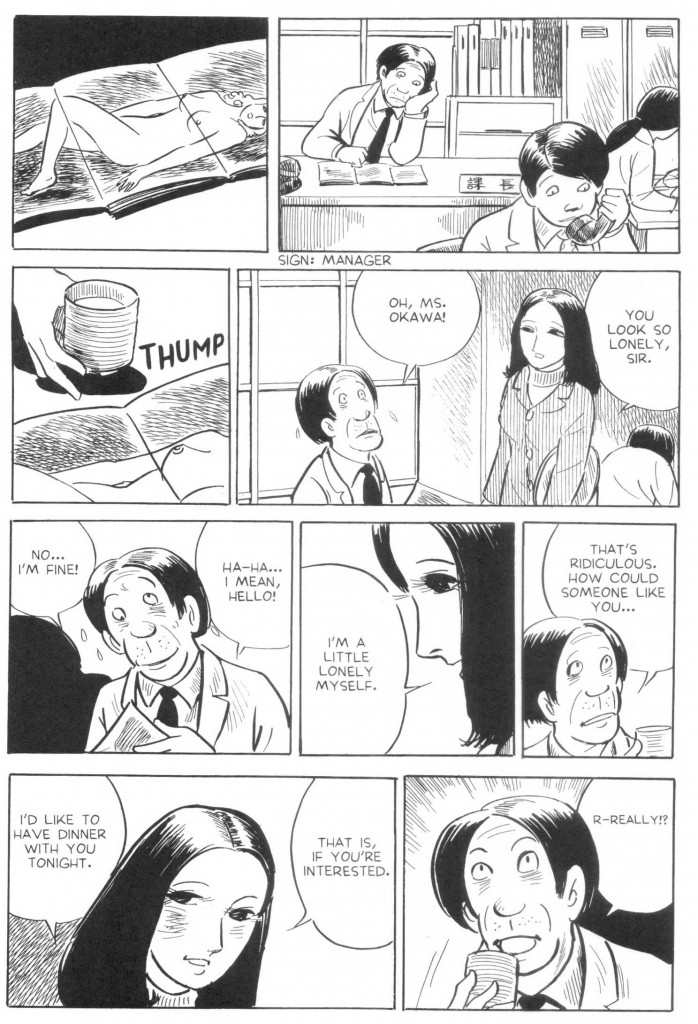


Nema komentara:
Objavi komentar